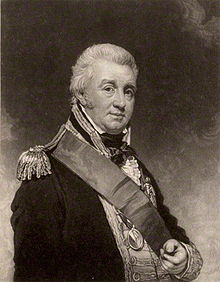Regency Personalities Series-Admiral Sir Alexander Cochrane
Regency Personalities Series
In my attempts to provide us with the details of the Regency, today I continue with one of the many period notables.
Admiral Sir Inglis Alexander Cochrane
23 April 1758 – 26 January 1832

Alexander Cochrane
Admiral Sir Alexander Cochrane was born a younger son of the Scottish peer Thomas Cochrane, the eighth Earl of Dundonald, and his wife. He joined the Royal Navy as a boy and served with British naval forces in North America. He served during the American War of Independence.
Cochrane also participated in the Egyptian operations in 1801. When Alexandria fell, Cochrane, in the 74-gun third-rate HMS Ajax, with the sixth-rate HMS Bonne Citoyenne, the HMS Cynthia, the brig-sloops HMS Port Mahon and HMS Victorieuse, and three Turkish corvettes, were the first vessels to enter the harbour.
In 1805 he was made commander of the Leeward Islands station. He conducted operations against the French and Spanish on 6 February 1806 at the Battle of San Domingo during the Napoleonic Wars. A cannonball blew his hat off his head while he was on the deck of his flagship, HMS Northumberland. He was knighted and appointed KCB on 29 March 1806 in recognition of his service. Other rewards included thanks from both Houses of Parliament, freedom of the city of London, and a sword valued at 100 guineas.
Following the concern in Britain that neutral Denmark was entering an alliance with Napoleon, with the rank of Rear-Admiral, he sailed in HMS Belleisle (74 guns) as commander of the squadron of ships that was sent to occupy the Danish West Indies. In 1809 he commanded naval forces in the conquest of Martinique.
From April 1814, during the War of 1812 against the United States, Cochrane, then a Vice Admiral, served as Commander-in-Chief of the North American Station, based at the new dockyard in Bermuda. He landed the force under General Ross that burned Washington and pushed successful naval forays at the same time. Initially he wanted to attack Rhode Island in New England after the success at Washington, but was dissuaded by Ross and Admiral Cockburn, who wanted to go after the bigger prize of Baltimore, Maryland.
During the Battle of Baltimore, Cochrane directed the bombardment of Fort McHenry in Baltimore, which proved ineffectual. He resisted calls to attack the fort more aggressively with frigates. He ordered a diversionary raid by boats to assist the army encamped near Baltimore in their proposed attack on Hampstead hill (which they cancelled and withdrew), but this diversion had no success. In Baltimore, the British used bomb vessels and rocket ship, which inspired Francis Scott Key’s poem that became “The Star-Spangled Banner,” the US national anthem.
Cochrane led the British force that won the Battle of Lake Borgne in December 1814 in Louisiana. His forces built a hard short road to New Orleans for use by British armed forces. But, the British army was defeated at the Battle of New Orleans in January 1815. As news that Britain had ratified the peace treaty (the Treaty of Ghent) had not reached the battlefield, the Battle of New Orleans was fought after the war was ended. The peace treaty was being carried to Washington for ratification by the United States Congress.
The Duke of Wellington held that the failure of the New Orleans campaign was largely the fault of Cochrane. In a eulogy to General Edward Pakenham — Wellington’s brother-in-law, killed at New Orleans, he said:
I cannot but regret that he was ever employed on such a service or with such a colleague. The expedition to New Orleans originated with that colleague…. The Americans were prepared with an army in a fortified position which still would have been carried, if the duties of others, that is of the Admiral (Sir Alexander Cochrane), had been as well performed as that of he whom we now lament.
Despite the lack of success at New Orleans, the British nonetheless went on to force the surrender of Mobile, Alabama and capture the United States Navy Flagship, the U.S.S. President and it’s commodore, Stephen Decatur outside New York Harbor. Cochrane was thus promoted to admiral in 1819. From 1821 to 1824, he was Commander-in-Chief, Plymouth. He died in Paris on 26 January 1832.
Cohrane was from Member of Parliament (MP) for Stirling Burghs from 1800 to 1802, and from 1803 to 1806.
In 1788 he married Maria Shaw; they had three sons and two daughters. His son Thomas John Cochrane was entered in the Royal Navy at the age of seven; he rose to become colonial governor of the colony of Newfoundland, and Admiral of the Fleet; he also received a knighthood in the Order of the Bath.
Alexander Cochrane was the sixth of the surviving sons of Thomas Cochrane, 8th Earl of Dundonald. The eldest son Archibald Cochrane became the earl and lost the family lands on a series of inventions and investments. Many of the younger sons served in the military or had careers supplying it. The next brother, Charles, served in the army and was killed at the Siege of Yorktown; he had married to Catherine, the daughter of Major John Pitcairn. The third surviving son, John Cochrane, was a paymaster and provisioner to the army and navy. His children included Nathaniel Day Cochrane, who became a rear admiral, and probably of the chess player John Cochrane. The next son, Basil Cochrane, made a fortune supplying the Royal Navy in India. Alexander was the sixth son. The seventh, George Augustus Frederick Cochrane, had an army career and served in Parliament. The youngest son, Andrew Cochrane-Johnstone, was an army officer, colonial governor, politician, and fraudster.
The Earl of St. Vincent wrote of the Cochrane brothers in 1806, “The Cochranes are not to be trusted out of sight, they are all mad, romantic, money-getting and not truth-telling—and there is not a single exception in any part of the family.”





